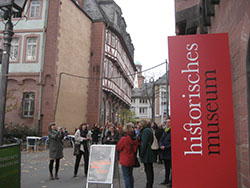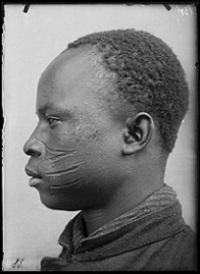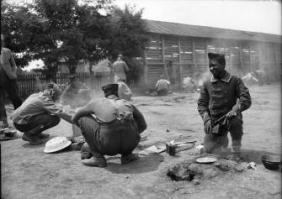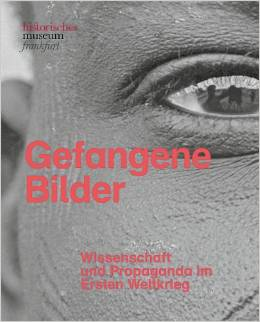Gefangene Bilder - Captive Portraits
 The farewell excursion
The farewell excursion
The library staff of the African Studies Centre spent a weekend in Frankfurt. As part of the farewell excursion for Katrien Polman the group visited the exhibition "Gefangene Bilder : Wissenschaft und Propaganda im Ersten Weltkrieg" (Captive Portraits. Science and Propaganda during World War One) at the Historisches Museum Frankfurt. And of course, the library purchased the exhibition catalogue.
The exhibition
 Portraits of ten French colonial soldiers are the main feature of the exhibition ”Captive Portraits. Science and Propaganda during World War One” at the Historisches Museum Frankfurt. Prisoners of war from Northern and Western Africa were photographed at the prisoner of war camp in Wünsdorf, 40 kilometers south of Berlin. But how do these photographs—which slumbered in an archive for nearly a hundred years—correspond to the more commonplace image of World War I? Who are these prisoners? Who took the photographs? And with what intention?
Portraits of ten French colonial soldiers are the main feature of the exhibition ”Captive Portraits. Science and Propaganda during World War One” at the Historisches Museum Frankfurt. Prisoners of war from Northern and Western Africa were photographed at the prisoner of war camp in Wünsdorf, 40 kilometers south of Berlin. But how do these photographs—which slumbered in an archive for nearly a hundred years—correspond to the more commonplace image of World War I? Who are these prisoners? Who took the photographs? And with what intention?
The men in the portraits had all been servicemen in the French army. Among the approximately seven million soldiers, 440,000 men were North and West Africans who had been recruited, in many cases by force. Thousands of them were taken prisoner by the Germans.
In the camps, the prisoners served as subjects of scientific study. Some scientists examined the prisoners for ostensible racial characteristics. Others were particularly interested in the prisoners’ cultures: they filmed the prisoners, recorded their music on vinyl records and registered the different languages as "voices of the peoples" on wax cylinders.
 One of the most colourful personalities was the explorer Leo Frobenius, founder of the institute of the same name: he collected stories told by the prisoners and published them later in his voluminous collection called "Atlantis – Volksmärchen und Volksdichtungen Afrikas" (Veröffentlichungen des Instituts für Kulturmorphologie. Herausgegeben von Leo Frobenius. 12 Bände. Jena: Diederichs 1921–1928) but without mentioning where and how he collected the stories.
One of the most colourful personalities was the explorer Leo Frobenius, founder of the institute of the same name: he collected stories told by the prisoners and published them later in his voluminous collection called "Atlantis – Volksmärchen und Volksdichtungen Afrikas" (Veröffentlichungen des Instituts für Kulturmorphologie. Herausgegeben von Leo Frobenius. 12 Bände. Jena: Diederichs 1921–1928) but without mentioning where and how he collected the stories.
The exhibition shows how the war provided new means of scientific research —and how scientists served political purposes.
The exhibition can be seen until 15 February 2015.
 The exhibition catalogue
The exhibition catalogue
The exhibition is accompanied by a catalogue published by Michael Imhof Verlag. The catalogue contains 150 colour pictures of the exhibits as well as essays by authors from Germany, France, the USA, and Senegal, examining questions raised by the portraits of the French colonial soldiers. All contributions are in the German language. Contributors: Sophie Bajart, Anna-Maria Brandstetter, Antoine Champeaux, Julie Coulombel, Eric Deroo, Katja Geisenhainer, Jean-Louis Georget, Jan Gerchow, Hélène Guillot, Margot Kahleyss, Karl-Heinz Kohl, Richard Kuba, Britta Lange, Joe Lunn und Sandra Maß. Editors: Benedikt Burkard and Céline Lebret.
Table of Contents
More titles in ASC library catalogue on World War I
Ursula Oberst
November 2014

